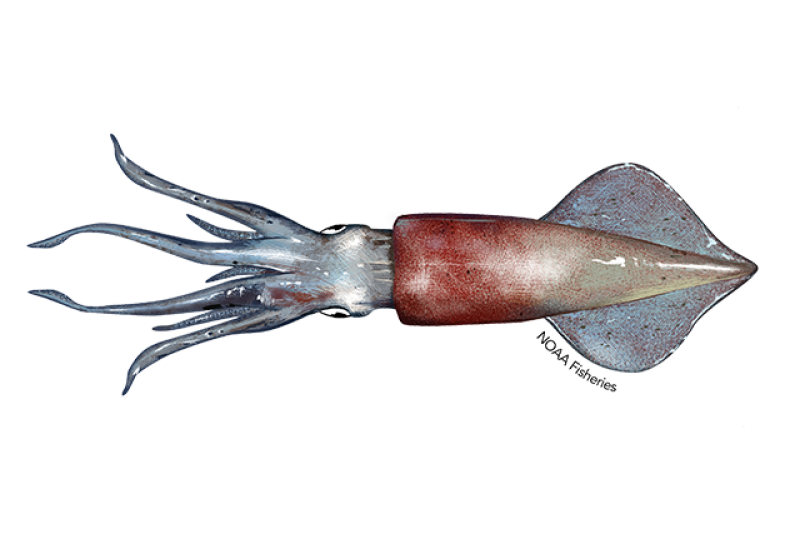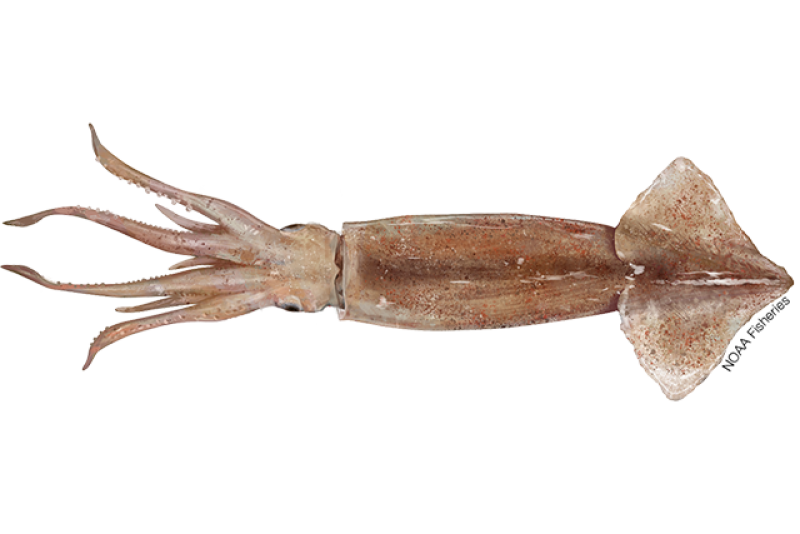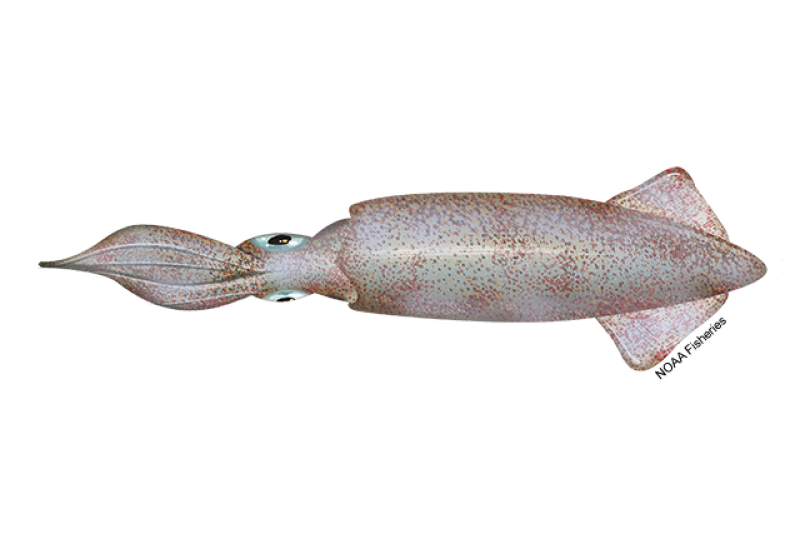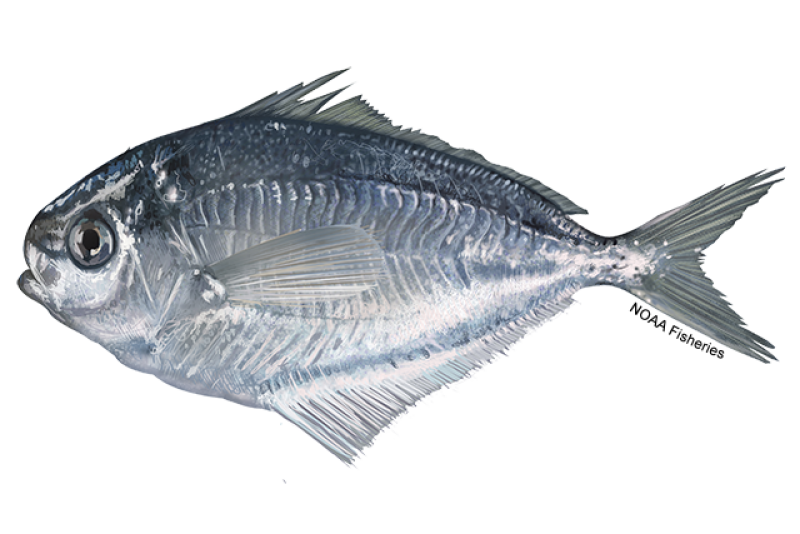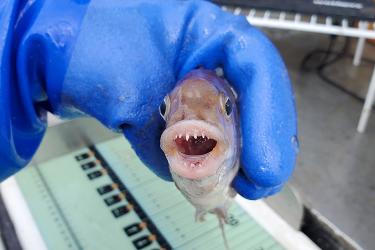Longfin Squid
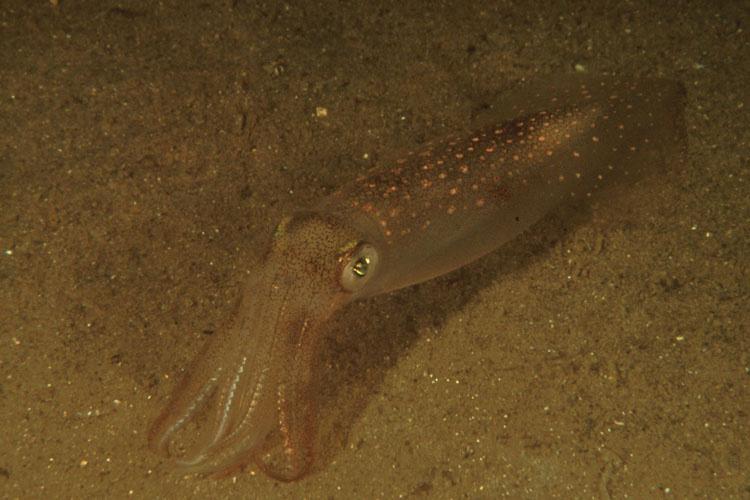 Longfin squid. Credit: National Undersea Research Center – University of Connecticut
Longfin squid. Credit: National Undersea Research Center – University of Connecticut
Longfin squid. Credit: National Undersea Research Center – University of Connecticut
About the Species
 Longfin squid. Credit: National Undersea Research Center – University of Connecticut
Longfin squid. Credit: National Undersea Research Center – University of Connecticut
Longfin squid. Credit: National Undersea Research Center – University of Connecticut
U.S. wild-caught longfin squid is a smart seafood choice because it is sustainably managed and responsibly harvested under U.S. regulations.

Population
The stock is not overfished.

Fishing Rate
Overfishing status is unknown, but management measures are in place.

Habitat Impact
Fishing gears used to harvest longfin squid have minimal impacts on habitat.

Bycatch
Regulations are in place to minimize bycatch.
Population Status
- The species has a lifespan of less than one year. According to the 2023 stock assessment, longfin squid is not overfished. There is currently not enough information to determine whether the stock is subject to overfishing. Summary stock assessment information can be found on Stock SMART.
Appearance
- Longfin squid have an internal shell called a “pen.”
- Their fins are long, at least half the length of the mantle (large part of the squid in front of the head).
- The head has large eyes that are covered by a cornea.
- They are pink or orange and mottled with brown or purple.
- They are likely color blind, but are able to use special pigment cells in their skin (called chromatophores) to change their color and patterns to escape predators or disguise themselves from prey.
Biology
- Longfin squid grow fast, up to 1.6 feet mantle length (large part of the squid in front of the head), but usually less than 1 foot.
- They have a short life span, reproducing right before they die at around six to eight months old.
- Their growth and development is highly sensitive to environmental conditions. Squid hatched in the summer grow faster than those hatched in the winter.
- They spawn year-round, with peak production in winter and summer. The male cements bundles of spermatophores into the mantle cavity of the female and/or deposits them in a pouch located near her mouth. The spermatophores penetrate the ova, or sperm is stored for later use.
- The female lays fertilized egg capsules that contain about 150 to 200 eggs each in clusters attached to the ocean bottom, with a typical female laying a total of 3,000 to 6,000 eggs. Eggs hatch between 11 and 26 days later, depending on water temperature.
- Small immature longfin squid feed on plankton, and larger squid feed on crustaceans and small fish.
- They are aggressive hunters, can consume fish larger than themselves, and do eat their own species.
- They are a key prey species for a variety of marine mammals, diving birds, and finfish species.
Where They Live
Range
- Longfin squid are found from Newfoundland to the Gulf of Venezuela.
- In the northwest Atlantic Ocean, longfin squid are most abundant between Georges Bank and Cape Hatteras, North Carolina.
Habitat
- Adults live over mud or sand/mud substrates of the continental shelf and upper continental slope in waters as deep as 1,300 feet.
- Adults and juveniles migrate vertically in the water column, remaining near the seabed during the day and moving toward the surface at night.
- North of Cape Hatteras, squid migrate seasonally—offshore during late autumn to spend the winter in warmer waters along the shelf edge and slope, and back inshore during the spring where they remain until late autumn.
- Squid egg masses are attached to rocks and small boulders or aquatic vegetation and on sandy bottoms.
- Paralarvae are found in surface waters. Juveniles also live in the upper water column in water 165 to 1,650 feet deep.
Fishery Management
- NOAA Fisheries and the Mid-Atlantic Fishery Management Council manage the longfin squid fishery.
- Managed under the Atlantic Mackerel, Squid, and Butterfish Fishery Management Plan:
- Fishermen with a limited access permit can fish for unlimited amounts of longfin squid while the fishery is open. All other fishermen must obtain an incidental catch permit, and have possession limits.
- An annual coastwide catch quota is divided into trimester allocations. Managers monitor annual quotas closely, as there can be large fluctuations in abundance from year to year.
- Managers set a cap on the amount of butterfish that can be incidentally caught in the longfin squid fishery to help prevent overfishing on the butterfish stock.
Harvest
- In 2023, commercial landings totaled 39 million pounds, and were valued at $39 million, according to the NOAA Fisheries commercial fishing landings database.
- Fisheries for longfin squid reflect the species’ seasonal migrations.
- The majority of landings come from Rhode Island, New York, New Jersey, and Massachusetts.
- Harvested for bait since the late 1800s, longfin squid have been harvested since the mid-1960’s for their mild, sweet meat.
- Gear types, habitat impacts, and bycatch:
- The majority of longfin squid is harvested year-round using small-mesh bottom trawls. There are now only a few fishermen that use pound nets and fish traps during the spring and early summer when squid migrate inshore.
- Sandy or muddy habitat, where squid are fished, is less sensitive to the impacts of trawling.
- Small-mesh bottom trawls can incidentally catch marine mammals and large pelagic species, including pilot whales, common dolphin, swordfish, and a variety of shark, ray, and tuna species. Finfish such as butterfish, hakes, Illex squid, fluke, herring, spiny dogfish, and Atlantic mackerel are also incidentally caught in this fishery.
- Measures to prevent or minimize bycatch include:
- Bycatch cap for butterfish caught in the longfin fishery.
- Minimum mesh size requirements for bottom trawl nets, but bycatch escapement is very limited because the codend mesh sizes are very small (1 7/8 in. during Trimester 2 and 2 1/8 in. during Trimesters 1 and 3) and are covered by an additional layer of mesh called a strengthener.
- Outreach to fishermen to educate them on actions to take in the event of a marine mammal interaction.
- Real-time communication to vessels regarding hotspots of marine mammal interactions.
Scientific Classification
- Longfin squid are found from Newfoundland to the Gulf of Venezuela.
- In the northwest Atlantic Ocean, longfin squid are most abundant between Georges Bank and Cape Hatteras, North Carolina.
- Adults live over mud or sand/mud substrates of the continental shelf and upper continental slope in waters as deep as 1,300 feet.
- Adults and juveniles migrate vertically in the water column, remaining near the seabed during the day and moving toward the surface at night.
- North of Cape Hatteras, squid migrate seasonally—offshore during late autumn to spend the winter in warmer waters along the shelf edge and slope, and back inshore during the spring where they remain until late autumn.
- Squid egg masses are attached to rocks and small boulders or aquatic vegetation and on sandy bottoms.
- Paralarvae are found in surface waters. Juveniles also live in the upper water column in water 165 to 1,650 feet deep.
Fishery Management
- NOAA Fisheries and the Mid-Atlantic Fishery Management Council manage the longfin squid fishery.
- Managed under the Atlantic Mackerel, Squid, and Butterfish Fishery Management Plan:
- Fishermen with a limited access permit can fish for unlimited amounts of longfin squid while the fishery is open. All other fishermen must obtain an incidental catch permit, and have possession limits.
- An annual coastwide catch quota is divided into trimester allocations. Managers monitor annual quotas closely, as there can be large fluctuations in abundance from year to year.
- Managers set a cap on the amount of butterfish that can be incidentally caught in the longfin squid fishery to help prevent overfishing on the butterfish stock.
Harvest
- In 2023, commercial landings totaled 39 million pounds, and were valued at $39 million, according to the NOAA Fisheries commercial fishing landings database.
- Fisheries for longfin squid reflect the species’ seasonal migrations.
- The majority of landings come from Rhode Island, New York, New Jersey, and Massachusetts.
- Harvested for bait since the late 1800s, longfin squid have been harvested since the mid-1960’s for their mild, sweet meat.
- Gear types, habitat impacts, and bycatch:
- The majority of longfin squid is harvested year-round using small-mesh bottom trawls. There are now only a few fishermen that use pound nets and fish traps during the spring and early summer when squid migrate inshore.
- Sandy or muddy habitat, where squid are fished, is less sensitive to the impacts of trawling.
- Small-mesh bottom trawls can incidentally catch marine mammals and large pelagic species, including pilot whales, common dolphin, swordfish, and a variety of shark, ray, and tuna species. Finfish such as butterfish, hakes, Illex squid, fluke, herring, spiny dogfish, and Atlantic mackerel are also incidentally caught in this fishery.
- Measures to prevent or minimize bycatch include:
- Bycatch cap for butterfish caught in the longfin fishery.
- Minimum mesh size requirements for bottom trawl nets, but bycatch escapement is very limited because the codend mesh sizes are very small (1 7/8 in. during Trimester 2 and 2 1/8 in. during Trimesters 1 and 3) and are covered by an additional layer of mesh called a strengthener.
- Outreach to fishermen to educate them on actions to take in the event of a marine mammal interaction.
- Real-time communication to vessels regarding hotspots of marine mammal interactions.
Scientific Classification
| Kingdom | Animalia | Phylum | Mollusca | Class | Cephalopoda | Order | Myopsida | Family | Loliginidae | Genus | Doryteuthis | Species | pealeii |
|---|
Last updated by NOAA Fisheries on 05/08/2025
Featured News
 A chef prepares various finger foods made from squid fins in the Dr. Matthew Highlands Food Pilot Plant in Hitchner Hall at the University of Maine. Several chefs were invited to create dishes as part of a research project to develop new frozen foods made from squid fins. Photo courtesy of the University of Maine.
A chef prepares various finger foods made from squid fins in the Dr. Matthew Highlands Food Pilot Plant in Hitchner Hall at the University of Maine. Several chefs were invited to create dishes as part of a research project to develop new frozen foods made from squid fins. Photo courtesy of the University of Maine.

Research Addresses Need for Bottom Trawl Survey Gear Standardization
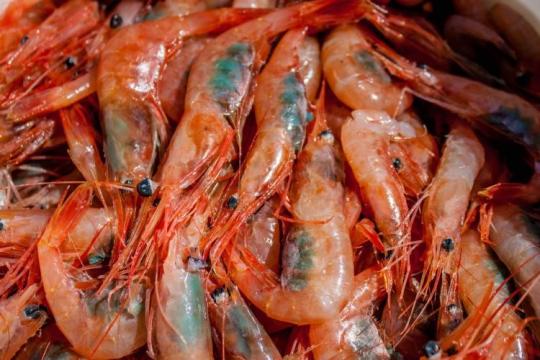
Northern Shrimp Population Collapse Linked to Warming Ocean Temperatures, Squid Predation
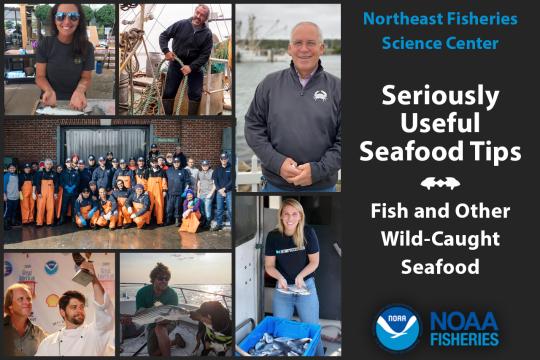
Seriously Useful Seafood Tips: Fish and Other Wild-Caught Seafood
Recreational Fishing Regulations
Possession Limits:
There is no recreational possession limit for longfin squid. If you are on a trip carrying paying customers and you possess longfin squid in federal waters, you must hold a Squid, Mackerel, and Butterfish Category 2 Charter/Party Permit.
Fish Size Limits:
Minimum Fish Size: None
Maximum Fish Size: None
Reporting A Recreational Catch
Charter/Party and Recreational Reporting
Catch Reporting and Vessel Trip Reports
If the owner of a party or charter boat is issued only a charter/party permit, and is carrying passengers for hire, then they must complete a VTR for each trip on which they land any fish.
Interactive Voice Response System Requirements
The Atlantic mackerel, squid, and butterfish fisheries do not have any IVR requirements. However, if you are participating in a research program such as research set-aside (RSA) or fishing with an exempted fishing permit (EFP), there are IVR requirements. Please refer to your RSA or EFP paperwork for instruction on using IVR.
Marine Recreational Information Program
The Marine Recreational Information Program (MRIP) is a system of coordinated voluntary data collection programs designed to estimate recreational catch and effort.
Last updated by NOAA Fisheries on 05/08/2025
Commercial Fishing Regulations
Current Specifications
Specifications are reviewed annually and are adjusted as new information becomes available.
2024 and Projected 2025-2026 Longfin Squid Specifications in Metric Tons (mt)
Specification | 2024 | 2025-2026 |
Overfishing limit (OFL) | Unknown | Unknown |
Acceptable biological catch (ABC) | 23,400 | 23,400 |
Commercial discard set-aside | 506.3 (2.16%) | 506.3 (2.16%) |
Initial optimum yield (IOY) | 22,893.7 | 22,893.7 |
Domestic annual harvest (DAH)/domestic annual processing (DAP) | 22,893.7 | 22,893.7 |
2024-2026 Longfin Squid Quota Trimester Allocations
Trimester | Percent | Metric Tons |
I (Jan-Apr) | 43 | 9,844.3 |
II (May-Aug) | 17 | 3,891.9 |
III (Sep-Dec) | 40 | 9,157.5 |
Total | 100 | 22,893.7 |
2024 Allocation of the Butterfish Mortality Cap among Longfin Squid Trimesters
Trimester | Percent | Allocation (mt) |
I (Jan-Apr) | 43 | 1,670 |
II (May-Aug) | 17 | 660 |
III (Sep-Dec) | 40 | 1,554 |
Total | 100 | 3,884 |
Trip Limits
| Permit Category | Illex Squid | Longfin Squid | Butterfish |
| SMB 3 Squid/Butterfish Incidental | 10,000 lb | 250 lb | 600 lb |
| SMB 1A Longfin Moratorium | - | Unlimited | - |
| SMB 1B Longfin Moratorium | - | 5,000 lb | - |
| SMB 1C Longfin Moratorium | - | 2,500 lb | - |
Fish Size Limits
Minimum fish size: Not applicable
Maximum fish size: Not applicable
Accountability Measures
Are there in-season adjustments (changes mid-fishing year) in this fishery? Yes. The quota allocated between trimesters for longfin squid and the butterfish catch cap can be reallocated in the following manner:
Trimester I underages: If there is an underharvest in Trimester I of 25 percent or more, then the amount of the underharvest will be reallocated to Trimester II and Trimester III. The Trimester II quota may be increased by a maximum of 50 percent, so any remaining portion of the underage will be reallocated to Trimester III. Any underages for Trimester I that are less than 25 percent of the Trimester I quota will be applied to Trimester III of the same year.
Trimester I overages: Any overages of commercial quota for Trimesters I and II will be subtracted from Trimester III of the same year.
Additionally, if NOAA Fisheries projects that the fishery will harvest a certain percentage of a trimester or annual quota for longfin squid, the directed fishery will be closed. See the summary of closure thresholds in the table below. Fishery closures will be published in the Federal Register, and announced via USCG and Vessel Monitoring System (VMS).
Longfin Squid | 90% in Trimesters I and II; 95% after April 15 and August 15 | 2,500 lb per trip in Trimesters 1 and III. 250 lb per trip in Trimester II. |
Longfin Squid | 95% in Trimester III | 2,500 lb per trip |
Butterfish Mortality Cap* | 95% in each Trimester | 2,500 lb of longfin squid per trip |
*Vessels using jigging gear to target longfin squid when the directed fishery is closed due to the butterfish mortality cap will not be subject to the reduced possession limit and will be allowed to possess more than 2,500 lb of longfin squid, provided that all trawl gear is properly stowed.
Reporting A Commercial Catch
Catch Reporting
Catch Reporting and Vessel Trip Reports (VTR): Owner/operators participating in the Longfin squid must submit trip reports weekly. Reports must be postmarked or received by midnight of the Tuesday following the reporting week (Sunday through Saturday). If a trip starts in one week, and offloads in the next, it should be reported in the week the catch was offloaded.
VMS Requirements: The owner or operator of a vessel issued a longfin squid moratorium permit must report catch (retained and discarded) of longfin squid daily via VMS. Reports are required even if longfin squid caught that day have not yet been landed.
Commercial Gear Information
Minimum Mesh Sizes
| Trimester | Minimum Mesh Size |
| Trimester I | 2 1/8 inches (54 mm) |
| Trimester II | 1 7/8 inches (48 mm) |
| Trimester III | 2 1/8 inches (54 mm) |
| Net strengtheners must be 5 inches or greater square or diamond mesh. | |
Last updated by NOAA Fisheries on 05/08/2025
Seafood Facts

Is Longfin Squid Sustainable?
U.S. wild-caught longfin squid is a smart seafood choice because it is sustainably managed and responsibly harvested under U.S. regulations.
Availability
Year-round.
Source
U.S. wild-caught from Southern Massachusetts to North Carolina.
Taste
Mild and slightly sweet.
Texture
Firm.
Color
Raw squid is ivory colored with a speckled membrane. Cooked squid is opaque white.
Health Benefits
Squid are an excellent source of selenium, riboflavin, and vitamin B12.
Nutrition Facts
Servings: 1; Serving Weight: 100 g; Calories: 92; Protein: 15.58 g; Total Fat: 1.38 g; Total Saturated Fatty Acids: 0.358 g; Carbohydrate: 3.08 g; Total Sugars: 0 g; Total Dietary Fiber: 0 g; Cholesterol: 233 mg; Selenium: 44.8 mcg; Sodium: 44 mgMore Information
Squid (Calamari) Recipes
Looking for some ways to add squid into your rotation? If you need cooking inspiration, browse these recipes for squid chowder, classic fried calamari, and more!

Last updated by NOAA Fisheries on 05/08/2025
Seafood News
 Celebrate Culinary Arts Month with a sustainable seafood recipe for every month of the year.
Celebrate Culinary Arts Month with a sustainable seafood recipe for every month of the year.
What Your Birth Month Says About Your Next Seafood Recipe
 Fresh-caught taʻape on ice. Credit: Conservation International Hawaiʻi.
Fresh-caught taʻape on ice. Credit: Conservation International Hawaiʻi.
Reducing Waste and Feeding Communities in Hawaiʻi with a Whole Fish Approach
 Chef Tyler Hadfield’s Curried Skate Wings with Tomato-Masala Chutney
Chef Tyler Hadfield’s Curried Skate Wings with Tomato-Masala Chutney
Ring In the New Year With These Crowd-Favorite Seafood Recipes
 NOAA Fisheries, in collaboration with Blue Ocean Mariculture, is conducting a multi-year pilot study to evaluate observational methods and tools for studying Hawaiian monk seal behavior. Courtesy of Blue Ocean Mariculture
NOAA Fisheries, in collaboration with Blue Ocean Mariculture, is conducting a multi-year pilot study to evaluate observational methods and tools for studying Hawaiian monk seal behavior. Courtesy of Blue Ocean Mariculture
AI Meets Aquaculture to Study Hawaiian Monk Seal Interactions With Net Pens
Regulated, Closed, and Access Areas
Atlantic Mackerel, Squid, and Butterfish Fishery Restricted Areas
| Oceanographer Canyon | Lydonia Canyon | Northern Scup Gear Restricted Area (GRA) | Southern Scup GRA |
| January 1–December 31 | January 1–December 31 | November 1–December 31 | January 1–March 15 |
| Bottom trawl gear prohibited | Bottom trawl gear prohibited | Minimum mesh size of 5.0 inch diamond mesh | Minimum mesh size of 5.0 inch diamond mesh |
| Transit allowed if bottom trawl gear is stowed and not available for immediate use. | Transit allowed if bottom trawl gear is stowed and not available for immediate use. | Transit allowed if codends less than 5.0 inches are stowed and not available for immediate use. | Transit allowed if codends less than 5.0 inches are stowed and not available for immediate use. |
| Applies to all permitted mackerel, squid, or butterfish vessels | Applies to all permitted mackerel, squid, or butterfish vessels | Applies to all trawl vessels fishing for longfin squid, black sea bass, or silver hake (whiting) | Applies to all trawl vessels fishing for longfin squid, black sea bass, or silver hake (whiting) |
*Coordinates for each area are listed below.
Oceanographer and Lydonia Canyons
| Oceanographer Canyon Coordinates | Lydonia Canyon Coordinates | |||
N. Lat. | W. Long. | N. Lat. | W. Long. | |
| 40°10.0' | 68°12.0' | 40°16.0' | 67°34.0' | |
| 40°24.0' | 68°09.0' | 40°16.0' | 67°42.0' | |
| 40°24.0' | 68°08.0' | 40°20.0' | 67°43.0' | |
| 40°10.0' | 67°59.0' | 40°27.0' | 67°40.0' | |
| 40°10.0' | 68°12.0' | 40°27.0' | 67°38.0' | |
| 40°16.0' | 67°34.0' | |||
Scup GRAs
| Southern GRA Coordinates | Northern GRA Coordinates | |||
N. Lat. | W. Long. | N. Lat. | W. Long. | |
| 39°20' | 72°53' | 41°00' | 71°00' | |
| 39°20' | 72°28' | 41°00' | 71°30' | |
| 38°00' | 73°58' | 40°00' | 72°40' | |
| 37°00' | 74°43' | 40°00' | 72°05' | |
| 36°30' | 74°43' | 41°00' | 71°00' | |
| 36°30' | 75°03' | |||
| 37°00' | 75°03' | |||
| 38°00' | 74°23' | |||
| 39°20' | 72°53' | |||
Illex Squid Exemption Area
Otter trawl vessels possessing longfin squid harvested in or from federal waters and fishing for Illex during the months of June, July, August in Trimester II, and September in Trimester III, are exempt from the longfin squid gear requirements specified in 50 CFR 648.23(a)(2), as long as:
- Any net, or any piece of net, with a mesh size less than 17⁄8 inches diamond mesh in Trimester II, and 21⁄8 inches diamond mesh in Trimester III, is stowed and not available for immediate use when the vessel is landward of the Illex Squid Exemption Area (coordinates below).
- Any net, or any piece of net, equipped with a net strengthener with a mesh opening smaller than 5 inches (diamond or square mesh) is stowed and not available for immediate use when the vessel is landward of the Illex Squid Exemption Area.

N. Lat. | W. Long. |
| 43°58.0′ | [1] |
| 43°58.0′ | 67°22.0′ |
| 43°50.0′ | 68°35.0′ |
| 43°30.0′ | 69°40.0′ |
| 43°20.0′ | 70°00.0′ |
| 42°45.0′ | 70°10.0′ |
| 42°13.0′ | 69°55.0′ |
| 41°00.0′ | 69°00.0′ |
| 41°45.0′ | 68°15.0′ |
| 42°10.0′ | [2] 67°10.0′ |
| 41°18.6′ | [2] 66°24.8′ |
| 40°55.5′ | 66°38.0′ |
| 40°45.5′ | 68°00.0′ |
| 40°37.0′ | 68°00.0′ |
| 40°30.0′ | 69°00.0′ |
| 40°22.7′ | 69°00.0′ |
| 40°18.7′ | 69°40.0′ |
| 40°21.0′ | 71°03.0′ |
| 39°41.0′ | 72°32.0′ |
| 38°47.0′ | 73°11.0′ |
| 38°04.0′ | 74°06.0′ |
| 37°08.0′ | 74°46.0′ |
| 36°00.0′ | 74°52.0′ |
| 35°45.0′ | 74°53.0′ |
| 35°28.0′ | 74°52.0′ |
| 35°28.0′ | [3] |
[1] The intersection of 43°58.0′ N. latitude and the US-Canada Maritime Boundary.
[2] Points M9 and M10 are intended to fall along and are connected by the US-Canada Maritime Boundary.
[3] The intersection of 35°28.0′ N. latitude and the outward limit of the U.S. EEZ.
More Information
Last updated by NOAA Fisheries on 05/08/2025
Management Overview
How is the fishery managed?
Mackerel, squid, and butterfish are jointly managed in federal waters by NOAA Fisheries and the Mid-Atlantic Fishery Management Council. The longfin squid fishery is managed through the use of permits, annual and trimester quotas, accountability measures, and possession limits.
What is the fishing year for this fishery?
January 1–December 31.
What are the different management areas for this fishery?
The management unit for longfin squid is the Atlantic Coast, but this species is predominately targeted from Massachusetts to North Carolina.
Management Plans
Mackerel, squid, and butterfish are managed in federal waters under the Atlantic Mackerel, Squid and Butterfish Management Plan (FMP).
Regulatory History
Management Timeline
1978: Atlantic Mackerel FMP established management of Atlantic mackerel fishery
1978: Atlantic Butterfish FMP established management of Atlantic butterfish fishery
1978: Squid FMP established management of squid fisheries
1979: Atlantic Mackerel Amendment 1 continued management of the Atlantic mackerel fishery
1979: Squid Amendment 1 continued management of the squid fishery
1980: Atlantic Butterfish Amendment 1 continued management of the Atlantic butterfish fishery
1980: Atlantic Mackerel Amendment 2 continued management of the Atlantic mackerel fishery.
1980: Atlantic Butterfish Amendment 2 continued management of the Atlantic butterfish fishery.
1983: Merged FMP consolidated management of Atlantic mackerel, squid, and butterfish fisheries under a single FMP.
1984: Amendment 1 implemented squid OY adjustment mechanism and revised the Atlantic mackerel mortality rate.
1986: Amendment 2 revised squid bycatch TALFF allowances, implemented framework adjustment process, converted expiration of fishing permits from indefinite to annual, and equated fishing year with calendar year.
1991: Amendment 3 established overfishing definitions for all four species.
1991: Amendment 4 limited the activity of directed foreign fishing and joint venture transfers to foreign vessels and allowed for specification of OY for Atlantic mackerel for up to three years.
1996: Amendment 5 adjusted Loligo MSY; eliminated directed foreign fisheries for Loligo, Illex, and butterfish; instituted a dealer and vessel reporting system; instituted an operator permitting system; implemented a limited access system for Loligo, Illex and butterfish; and expanded the management unit to include all Atlantic mackerel, Loligo, Illex, and butterfish under U.S. jurisdiction.
1997: Amendment 6 revised the overfishing definitions for Loligo, Illex, and butterfish; established directed fishery closure at 95 percent of DAH for Loligo, Illex and butterfish with post-closure trip limits for each species; and established a mechanism for seasonal management of the Illex fishery to improve the yield-per recruit.
1997: Amendment 7 established consistency among FMPs in the NE region of the U.S. relative to vessel permitting, replacement and upgrade criteria.
1998: Amendment 8 brought the FMP into compliance with new and revised National Standards and other required provisions of the Sustainable Fisheries Act. This action also added a framework adjustment procedure.
2001: Framework 1 (PDF, 80 pages) created a quota set-aside for the purpose of conducting scientific research
2002: Framework 2 (PDF, 4 pages) extended the moratorium on entry to the Illex fishery for an additional year; established that previous year specifications apply when specifications for the management unit are not published prior to the start of the fishing year (excluding TALFF specifications); and allowed for the specification of management measures for Loligo for a period of up to three years.
2003: Framework 3 (PDF, 3 pages) extended the moratorium on entry to the Illex fishery for an additional year.
2004: Framework 4 extended the moratorium on entry to the Illex fishery for an additional five years
2007: Amendment 12 implemented standardized bycatch reporting methodology.
2008: Amendment 9 allowed for multi-year specifications for all four managed species (mackerel, butterfish, Illex, and Loligo) for up to 3 years; extended the moratorium on entry into the Illex fishery, without a sunset provision; adopted biological reference points for Loligo recommended by the stock assessment review committee (SARC); designated EFH for Loligo eggs based on available information; and prohibited bottom trawling by MSB-permitted vessels in Lydonia and Oceanographer Canyons.
2010: Amendment 10 implemented a butterfish rebuilding program, increased the Loligo minimum mesh in Trimesters 1 and 3, and implemented a 72-hour trip notification requirement for the Loligo fishery.
2010: Amendment 13 implemented Annual Catch Limits (ACLs), Annual Catch Targets (ACTs), and Accountability Measures (AMs).
2011: Amendment 11 implemented Limited Access in the Atl. mackerel fishery, updated EFH for all MSB species, and established a recreational-commercial allocation.
2012: Framework 5 broadened the scope of individuals who can perform hold measurements for limited access mackerel vessels
2012: Framework 6 clarified the Council's risk policy and describes the limited circumstances under which acceptable biological catch (ABC) can be increased for stocks without status determination criteria on overfishing.
2013: Framework 7 converted the butterfish mortality cap from a catch cap to a discard cap
2014: Amendment 14 implemented a variety of reporting and monitoring requirements for Atlantic mackerel and longfin squid fisheries, and implemented a river herring and shad catch cap for the Atlantic mackerel fishery (Appendices). Final Rule.
2013: Amendment 17 modified accountability measures for the Council's recreational fisheries, including Atlantic mackerel. Final Rule.
2014: Framework 8 implemented changes to improve operation of the butterfish discard cap in the longfin squid fishery and the directed butterfish fishery. Final Rule.
2015: Amendment 15 implemented Standardized Bycatch Reporting Methodology. Final Rule.
2015: Amendment 19 eliminated the requirement for vessel owners to submit "did not fish" reports for the months or weeks when their vessel was not fishing. This action also removed some of the restrictions for upgrading vessels listed on Federal fishing permits. Final Rule.
2015: Framework 9 established measures to enhance catch monitoring and address slippage (catch that is discarded before it has been sampled by observers) in the Atlantic mackerel fishery.
2016: Amendment 16 - Deep Sea Corals Amendment established management measures to protect deep sea corals from the impacts of commercial fishing gear in the Mid-Atlantic region. Final Rule.
2017: Amendment 18 - Unmanaged Forage Omnibus Amendment implemented management measures to prevent the development of new, and the expansion of existing, commercial fisheries on certain forage species in the Mid-Atlantic. Final Rule.
2017: Framework 10 - Omnibus For-Hire Electronic Trip Reporting Framework implemented a requirement for vessels that hold party/charter permits for Council-managed species to submit vessel trip reports electronically (eVTRs) while on a trip carrying passengers for hire.
2018: Framework 11 - Omnibus Acceptable Biological Catch Framework established a process for setting constant multi-year Acceptable Biological Catch (ABCs) limits for Council-managed fisheries; clarified that the Atlantic Bluefish, Tilefish, and Atlantic Mackerel, Squid, and Butterfish FMPs will now automatically incorporate the best available scientific information in calculating ABCs (as all other Mid-Atlantic management plans do) rather than requiring a separate management action to adopt them; clarified the process for setting ABCs for each of the four types of ABC control rules. Final Rule.
2018: Amendment 20 - Squid Amendment reduced latent directed permits, created limited access incidental permits, and lowered Trimester 2 post-closure trip limit to 250 pounds to discourage directed fishing after closures. Final Rule.
2018: Framework 12 - Atlantic Mackerel Closure Provisions Framework allow the possession of 5,000 lb of Atlantic mackerel after 100 percent of the domestic annual harvest is caught instead of prohibiting the possession of Atlantic mackerel for the rest of the year. Final Rule.
2019: Framework 13 - Established a 5-year rebuilding plan for Atlantic mackerel, set 2019-2021 mackerel specifications, modified the Mid-Atlantic Council’s risk policy, and modified in-season closure measures for mackerel. Final Rule.
2020: Amendment 21 - Chub Mackerel Amendment established management of Atlantic chub mackerel through the Mackerel, Squid, and Butterfish FMP. Final Rule.
2020: Framework 14 - Omnibus Commercial Electronic Reporting Framework established a requirement for commercial vessels with federal permits for Mid-Atlantic and New England Council-managed species to submit eVTRs within 48 hrs after the conclusion of a trip. Final Rule.
2020: Framework 15 - Omnibus ABC and Risk Policy Framework modified the Mid-Atlantic Council’s ABC control rule and risk policy. Final Rule.
2023: Amendment 23 - Atlantic Mackerel Rebuilding 2.0 Amendment revised the rebuilding plan for mackerel, set 2023 mackerel fishery specifications, established a recreational possession limit for mackerel, and modified in-season closure measures for mackerel to include an initial closure with different thresholds based on time of year (before vs. on/after May 1) and a final closure when the fishery is close to harvesting the full commercial quota. Final Rule.
2024: Framework 16 - Illex Hold Framework established a hold capacity baseline requirement for limited access Illex squid vessels, allowed NOAA Fisheries to collect processing type information from limited access Illex and Tier 1 longfin squid vessels, and clarified existing VMS requirements.
Under Development
None at this time.
More Information
Last updated by NOAA Fisheries on 05/08/2025
Science Overview
NOAA Fisheries conducts various research activities on the biology, behavior, and population health of longfin squid. The results of this research are used to inform management decisions for this species.
For detailed information about stock status, management, assessments, and resource trends, you can search for longfin squid, or any other species of interest, using NOAA’s StockSMART web tool.
Stock Assessment Review Index
Fishery Stock Assessments in New England and the Mid-Atlantic provides general information about stock assessments, and the Stock Assessment Review Index contains copies of completed assessment documents.
Recent Science Blogs
Last updated by NOAA Fisheries on 05/08/2025
Data & Maps
Research
Ecosystem and Socioeconomic Profile Development and Reports
Status of Ecosystem and Socioeconomic Profiles for Northeast fishery stock assessments.
Last updated by NOAA Fisheries on 05/08/2025
